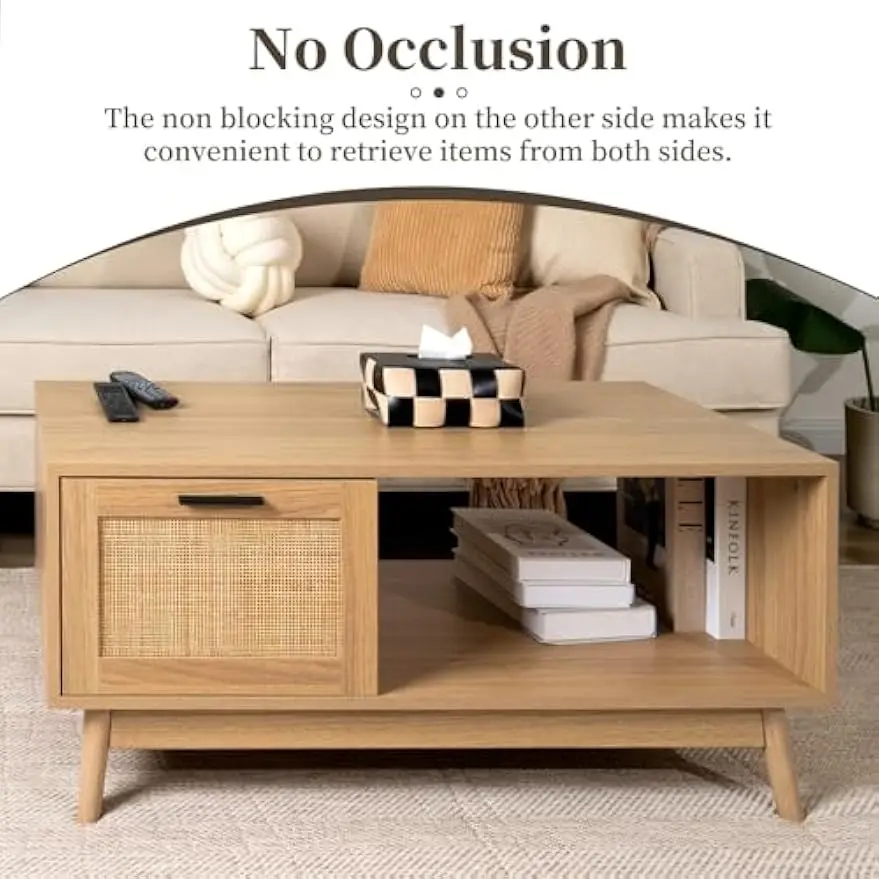Understanding Mid-Century Modern Coffee Tables
Mid-century modern design represents one of the most influential aesthetic movements of the 20th century, flourishing from the 1940s through the 1960s. This design style emerged as a response to the changing American lifestyle after World War II, embracing simplicity, functionality, and a connection to nature while incorporating technological advances of the era.
The hallmark characteristics that define authentic mid-century modern coffee tables include:
- Clean, sleek lines with minimal ornamentation
- Organic and geometric shapes working in harmony
- Emphasis on function without sacrificing beauty
- Mix of traditional and non-traditional materials
- Tapered legs that create a sense of lightness
- Integration of different textures and materials
- Bold colors combined with natural wood tones
What makes mid-century modern coffee tables so special is their perfect balance of artistic expression and practical functionality. These pieces weren’t just designed to look beautiful—they were created to serve everyday needs while elevating the spaces around them.
The enduring appeal of mid-century coffee tables lies in their timeless quality. Unlike trends that quickly fade, these designs remain relevant decades later because they solved furniture problems in elegant, lasting ways. The principles that guided their creation—prioritizing clean lines, honest materials, and functional beauty—resonate just as strongly today as they did when they first revolutionized home design.
The mid-century modern coffee table styles we admire today were created by visionary designers who believed good design should be accessible to everyone. Their innovative approach to materials, manufacturing, and form continues to inspire contemporary furniture makers and enthusiasts alike.
Understanding the design advantages of large mid-century coffee tables helps appreciate why these pieces remain highly sought-after collector’s items and focal points in modern homes. Their ability to blend seamlessly with various interior styles—from completely vintage spaces to eclectic contemporary settings—showcases their remarkable versatility.
What Makes a Coffee Table “Large”? Finding the Right Scale
When describing coffee tables as “large,” we’re referring to specific dimensions that set them apart from standard or compact options. Understanding these measurements helps ensure you select a piece that creates the right visual impact without overwhelming your space.
Generally speaking, large coffee tables typically measure:
– Length: Over 48 inches (122 cm)
– Width: Between 24-36 inches (61-91 cm)
– Height: Typically 16-18 inches (41-46 cm), aligned with standard sofa seat heights
The proportional relationship between your coffee table and surrounding furniture is crucial for creating a balanced look. A widely accepted design principle suggests your coffee table should measure approximately two-thirds the length of your sofa. This creates visual harmony while maintaining functionality.
For example, if your sofa is 84 inches long, an ideal large coffee table would measure around 56 inches in length. This proportion ensures the table feels substantial enough to anchor the seating area while leaving comfortable space for movement.
When browsing mid-century modern large coffee tables, consider how the scale impacts both aesthetics and function. A properly sized large coffee table serves as an intentional focal point rather than an awkward obstacle.
Room size naturally influences what “large” means for your space. In a spacious open-concept living area, a 60-inch coffee table might look perfectly proportioned, while the same table would overwhelm a compact apartment living room. The key is maintaining proper clearance—ideally 18 inches (46 cm) between the table edge and surrounding seating—to allow comfortable movement.
The height relationship between your coffee table and seating is equally important. Your coffee table should be either equal to or slightly lower than your sofa seat height for maximum comfort when reaching for items. This consideration is particularly important when selecting large mid-century coffee tables for homes with varied seating heights.
Finding the right scale creates a sense of intentional design rather than a room that feels randomly assembled. When a large mid-century coffee table is properly sized for its environment, it becomes a natural gathering point that enhances both the room’s functionality and its visual appeal.
Essential Considerations When Choosing a Large Mid-Century Coffee Table
Room Proportions and Layout
Before selecting a large coffee table, carefully assess your room’s dimensions and traffic patterns. Start by measuring the entire seating area, not just the open space where the table will sit. Consider creating a template using newspaper or painter’s tape to visualize how the table’s footprint will impact movement through the room.
The golden rule for coffee table placement is maintaining at least 18 inches (46 cm) of clearance between the table and surrounding seating. This allows people to move comfortably without feeling cramped. For dining-height tables, this clearance should increase to 24 inches (61 cm).
Existing furniture arrangement significantly impacts your table options. Consider whether your seating is arranged in a U-shape, L-shape, or parallel configuration, as this determines the ideal table shape and size. For example, rectangular spaces generally work better with rectangular or oval tables, while square arrangements complement round or square tables.
Working with expert arrangement room guidance for large coffee tables can help avoid common placement mistakes that disrupt flow or create awkward spaces.
Functional Requirements
How you plan to use your coffee table should heavily influence your selection. Consider these common functions:
- Casual dining and entertaining (prioritize surface area and stability)
- Display for books and decorative objects (consider surface area and arrangement possibilities)
- Storage for remote controls, games, or blankets (look for drawers, shelves, or compartments)
- Workspace for laptops or crafts (prioritize height and surface durability)
- Family game nights (stable, wide surfaces work best)
Many mid-century tables excel at multifunctional use, with thoughtful features like extending tops, height adjustment, or integrated storage. Being honest about your living patterns helps identify which functional aspects deserve priority.
Design Cohesion
Your large coffee table will inevitably become a focal point in your room, so consider how it will interact with your existing furniture and overall aesthetic. While mid-century pieces are remarkably versatile, pay attention to:
- Wood tones and finishes that complement other wooden elements
- Material compatibility with other prominent pieces
- Scale proportion relative to surrounding furniture
- Shape harmony with other major elements in the room
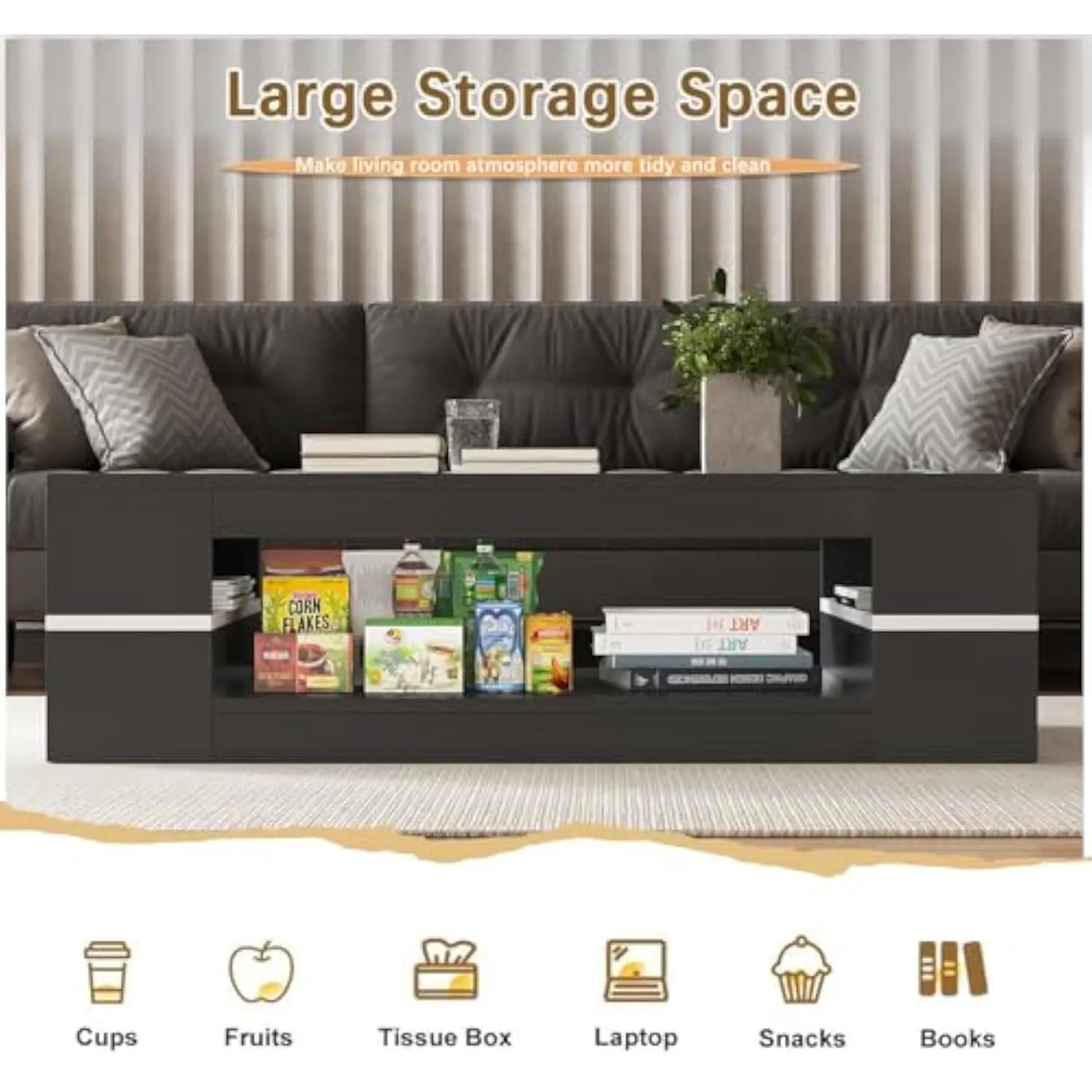
When space planning with oversized mid-century coffee tables, remember that these substantial pieces create visual weight. Balance this by ensuring other elements in the room don’t compete for attention. In open floor plans, a large coffee table can help define the seating area as a distinct zone within the larger space.
Signature Materials of Mid-Century Coffee Tables
Wood: The Cornerstone of Mid-Century Design
Wood forms the foundation of authentic mid-century coffee table design, with specific species chosen for their distinctive grain patterns, warmth, and durability. The most revered woods in mid-century design include:
Walnut: Perhaps the quintessential mid-century material, walnut offers rich, dark tones and striking grain patterns that develop a lustrous patina over time. Its strength and stability made it ideal for the clean-lined forms of mid-century design.
Teak: Prized for its natural oils that resist moisture and wear, teak develops a beautiful silver-gray patina if left untreated. Its golden-brown color and straight grain made it popular for both indoor and outdoor mid-century pieces.
Oak: Often used in its lighter, natural finish, oak provides excellent durability and a distinctive grain that adds subtle texture to minimalist designs.
Caring for solid wood mid-century modern coffee tables requires regular dusting with a soft cloth and occasional treatment with appropriate wood oils or waxes. Avoid harsh chemicals, excessive moisture, and direct sunlight, which can damage finishes and cause warping over time.
Glass: Adding Visual Lightness
Glass tops became a signature element in mid-century coffee table design, serving both aesthetic and practical purposes. Visually, glass creates a sense of lightness and space, allowing sculptural bases to shine as the star design element. Practically, glass offers a durable, heat-resistant surface that showcases the wood or metal elements beneath.
Most mid-century modern glass top coffee tables feature tempered safety glass that resists breaking and, if broken, shatters into small, less dangerous pieces. Glass thickness typically ranges from 3/8” to 1/2” (10-12mm), providing stability without appearing overly heavy.
Common glass treatments in authentic mid-century designs include:
– Clear glass that puts focus on the base design
– Smoked or tinted glass that adds subtle color depth
– Frosted or textured glass that offers privacy and hides fingerprints
Metal Elements: Structure and Detail
Metals in mid-century coffee tables typically serve as structural elements or distinctive accents rather than primary materials. The most common metals include:
Brass: Often used for legs, frames, or hardware, brass adds warmth and sophistication with its golden hue. Unlacquered brass develops a desirable patina over time.
Steel: Frequently found in hairpin legs or structural frames, steel offers strength while maintaining visual lightness. Chrome-plated steel provides a bright, reflective finish popular in more Space Age-inspired designs.
Aluminum: Less common but notable for its lightweight properties and resistance to corrosion, aluminum appears in some iconic mid-century table bases and accents.
Mixed Materials: Creative Combinations
The true genius of mid-century design often shines in how materials are combined to create functional art. Common pairings include:
- Wood frames with glass tops that highlight the sculptural quality of the wooden elements
- Wooden surfaces with metal legs that create an appealing contrast between warm and cool materials
- Two-tone wood combinations that emphasize geometric patterns and visual interest
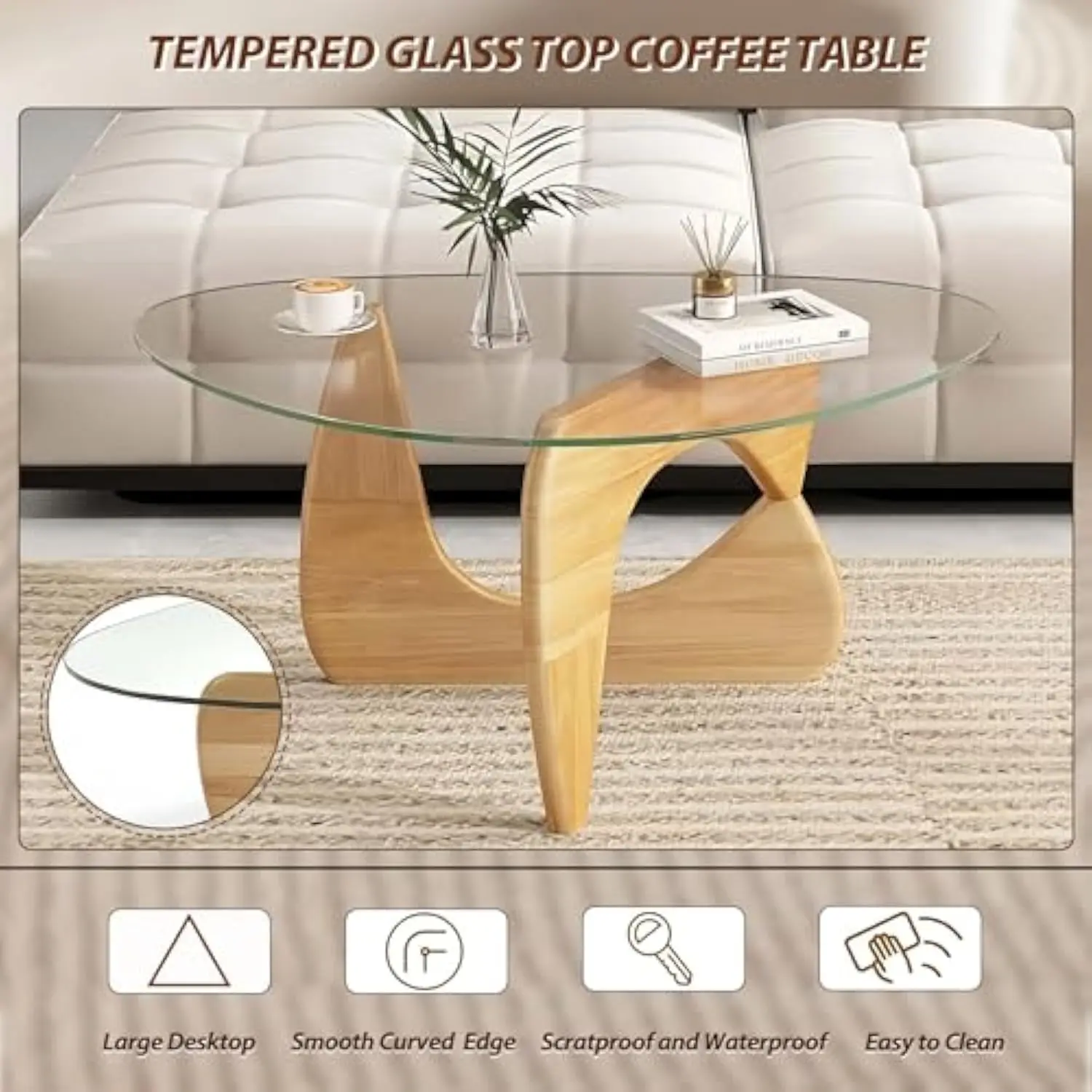
Understanding the characteristics and qualities of solid wood coffee table materials helps appreciate why these pieces maintain their beauty and functionality decades after their creation. The thoughtful material selection represents a defining aspect of mid-century design philosophy—honest materials selected for both beauty and purpose.
Distinctive Design Elements of Large Mid-Century Coffee Tables
What sets mid-century coffee tables apart from other design styles are their distinctive architectural elements that blend form and function in revolutionary ways. Understanding these signature features helps identify authentic mid-century design and appreciate the thoughtfulness behind each element.
Iconic Leg Designs
Mid-century tables stand—quite literally—on their distinctive leg designs:
- Tapered legs: Angling inward toward the floor, these create a sense of lightness and elegance while remaining sturdy
- Hairpin legs: Thin metal rods bent into sleek shapes that offer remarkable strength despite their minimalist profile
- Splayed legs: Angling outward from the table’s center to provide stable support while creating dynamic visual tension
- Pedestal bases: Sculptural central supports that eliminate the need for corner legs, allowing for more flexible seating arrangements
Signature Silhouettes
The overall shapes of mid-century coffee tables range from purely geometric to organically inspired:
- Rectangle and square tables with clean, crisp edges
- Oval and round tables that soften the look while maintaining geometric precision
- Kidney and boomerang shapes that introduce organic, biomorphic forms
- Modular and nesting designs that prioritize flexibility and function
Edge Treatments
The profile of a table’s edge significantly impacts its overall character:
- Knife-edge profiles that create razor-thin visual lines
- Beveled edges that catch light and create dimension
- Bull-nosed rounded edges that soften the overall appearance
- Raised lip edges that prevent items from sliding off
Exploring the features of large mid-century modern tables reveals how these elements work together to create cohesive designs. Each design choice serves both aesthetic and functional purposes—the hallmark of thoughtful mid-century design.
Surface Treatments
Surface design elements add further visual interest:
- Book-matched wood veneers that create mirror-image grain patterns
- Inlaid materials like contrasting woods or tiles that create geometric patterns
- Colored laminate surfaces that introduced bold hues while providing durability
- Textured surfaces that add tactile appeal and visual complexity
These distinctive elements combine to create coffee tables that function as practical furniture while simultaneously serving as sculptural art pieces. The careful balance between organic and geometric influences defines the mid-century modern aesthetic, with designs that feel simultaneously grounded in nature yet forward-looking in their execution.
5 Classic Large Mid-Century Coffee Table Styles
1. Rectangular Tables with Tapered Legs
Perhaps the most iconic mid-century coffee table style, these pieces feature clean rectangular tops supported by angled legs that taper down toward the floor. The streamlined silhouette captures the essence of mid-century design philosophy—functional, understated elegance with architectural interest.
Size considerations are particularly important with rectangular tables, as they tend to be the largest option. For optimal balance, look for tables approximately two-thirds the length of your sofa, typically 48-60 inches (122-152 cm) for large versions. Width typically ranges from 24-30 inches (61-76 cm) to allow comfortable reach from all seating positions.
Rectangular mid-century modern coffee tables work particularly well in:
– Traditional rectangular living rooms
– Spaces with parallel seating arrangements
– Rooms where the coffee table needs to serve multiple functions
– Settings where a strong, central anchor piece is desired
Styling approaches that complement these tables include asymmetrical arrangements that balance the table’s geometric precision, stacks of large art books that echo the clean lines, and selective decorative objects that don’t overwhelm the table’s inherent beauty.
2. Organic and Biomorphic Tables
Embracing nature-inspired curves and irregular shapes, organic mid-century coffee tables stand in creative contrast to their more geometric counterparts. These free-flowing designs feature soft, curved edges that evoke natural forms like river stones, amoebas, or kidney shapes.
The statement potential of these tables is significant—they often become conversation pieces and room defining elements. Their unusual silhouettes demand adequate space, requiring careful consideration of traffic patterns around their non-standard perimeters.
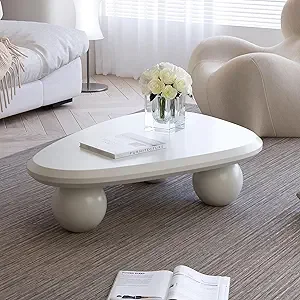
Understanding the differences between rectangular coffee tables and round mid-century tables helps determine which style better suits your space. Biomorphic tables pair beautifully with:
– Clean-lined modern sofas that provide contrast
– Curved seating that echoes their organic nature
– Spaces that benefit from softened transitions between elements
– Rooms where a sculptural focal point is desired
3. Glass-Top Tables with Sculptural Bases
These sophisticated tables feature transparent or smoked glass tops that showcase artistically designed bases beneath. By utilizing glass, designers could create tables with substantial surface area while maintaining visual lightness in a room.
The visual effect is one of floating planes that don’t interrupt sightlines across a room. This makes these tables particularly valuable in smaller spaces or settings where preserving an open feeling is important. The transparency of the top puts focus on the base, which often features:
– Intricately arranged wooden elements in geometric patterns
– Sculptural metal forms with dynamic angles
– Organic wood shapes that showcase natural beauty
– Architectural structures inspired by atomic-age imagery
Maintenance considerations include regular glass cleaning to maintain transparency and occasional attention to the base elements. These tables create excellent display opportunities for objects that benefit from being viewed from multiple angles.
4. Tiered and Multi-Level Tables
Addressing both aesthetic and functional needs, tiered mid-century coffee tables feature multiple surface levels that create visual interest while providing practical separation of items. Typically featuring two distinct surfaces—one higher level for immediate needs and a lower shelf for storage or display—these designs maximize functionality without sacrificing style.
The visual interest comes from the interplay between levels, often connected by sculptural elements or distinguished by different materials. These designs particularly excel at:
– Creating organized display areas for collections
– Providing practical separation between everyday items and decorative objects
– Adding architectural depth to a room through layered horizontal planes
– Maximizing functional surface area without increasing floor footprint
5. Expandable and Modular Coffee Tables
Emphasizing flexibility, these innovative designs feature adjustable elements that can be reconfigured based on changing needs. From nesting tables that can be separated for entertaining to designs with extending panels that create additional surface area, these pieces embody the mid-century emphasis on adaptable living.
Key features often include:
– Surfaces that lift, extend, or rotate to create new configurations
– Modular components that can be arranged in multiple patterns
– Nesting elements that can be fully separated when needed
– Integrated storage that appears only when activated
These versatile pieces are particularly well-suited for:
– Multi-purpose rooms with changing functional requirements
– Smaller spaces that benefit from adaptable furniture
– Homes where entertaining and daily use create different demands
– Settings where occasional extra table space is needed
Learning to master the statement piece potential of large coffee tables helps utilize these classic designs to their fullest potential, creating spaces that honor mid-century principles while meeting contemporary needs.
Functionality Features to Consider
Beyond their striking aesthetics, mid-century coffee tables often incorporate thoughtful functional features that enhance their everyday usability. These practical elements reflect the mid-century ethos of creating furniture that beautifully serves real-life needs.
Integrated Storage Solutions
Many large mid-century coffee tables feature cleverly incorporated storage that maintains clean lines while providing practical organization:
Drawers: Often seamlessly integrated into the table’s profile, drawers provide hidden storage for remote controls, coasters, and other small items that tend to clutter surfaces.
Open Shelves: Frequently positioned below the main table surface, these shelves create display space for books and magazines while keeping them easily accessible.
Compartments: Some designs feature divided storage areas within drawers or under lift-top surfaces, bringing organization to smaller items.
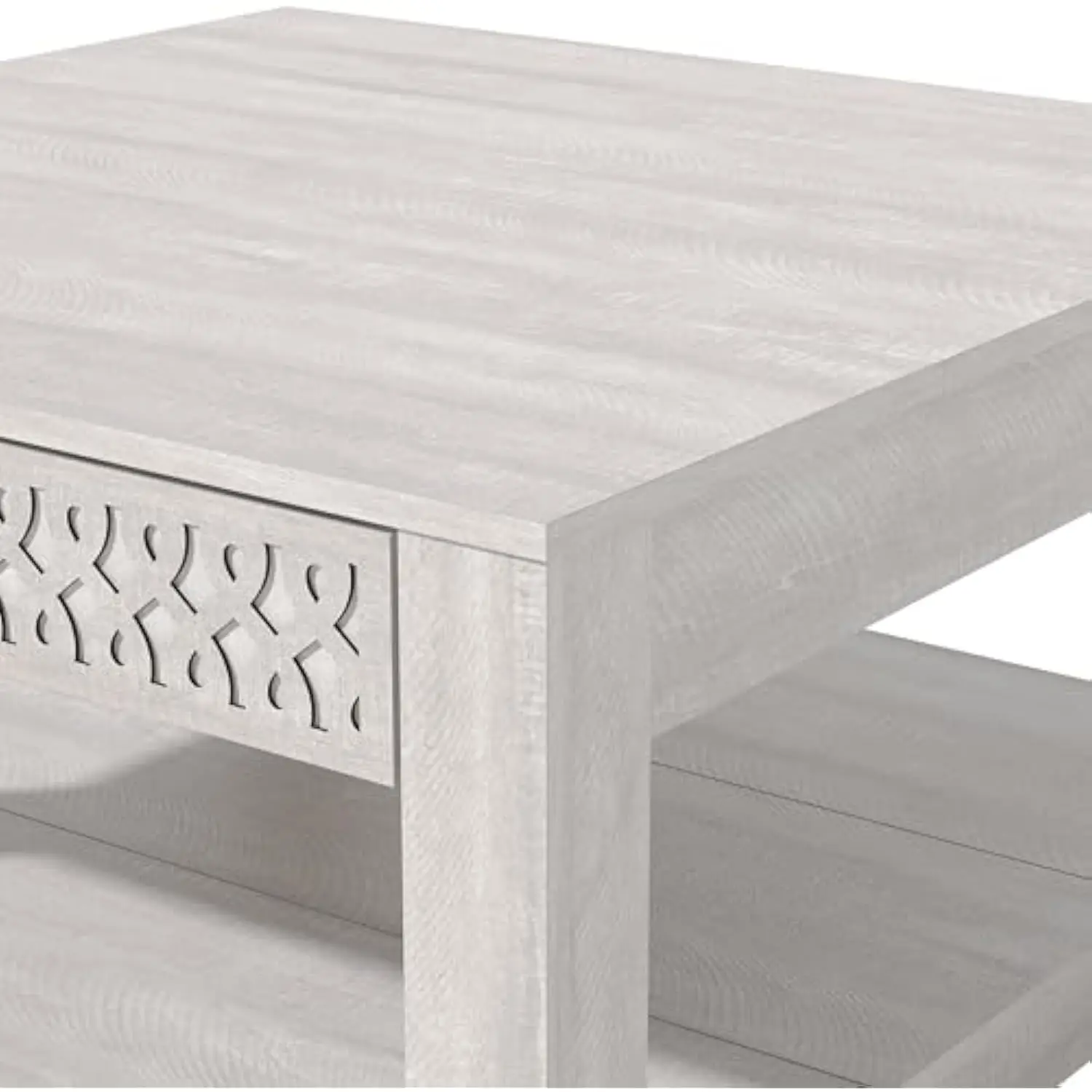
Versatility Features
The adaptability of mid-century coffee tables showcases their forward-thinking design approach:
Lift-top Mechanisms: These ingenious designs allow the surface to raise up and toward the sitter, creating an impromptu work surface at proper height for laptop use or dining.
Expandable Surfaces: Some tables include panels that slide out or leaves that fold open to increase surface area when needed for entertaining.
Adjustable Heights: Certain models feature mechanisms to raise or lower the entire table surface, transitioning between coffee and dining heights.
Lift-top coffee tables represent one of the most practical mid-century innovations, combining form and function in a way that remains relevant for today’s multi-purpose living spaces.
Durability Considerations
When evaluating functionality, consider how the table’s construction will withstand your household’s specific needs:
Surface Durability: Different finishes offer varying resistance to heat, moisture, and scratching. Homes with children might prioritize more forgiving surfaces like thick glass or certain wood finishes.
Structural Stability: Tables with cantilevered elements or minimal leg support should be assessed for stability, particularly in homes with active children or pets.
Weight Capacity: Consider whether the table needs to support substantial weight, such as for someone sitting on the edge or placing heavy objects on the surface.
Understanding the various functional uses for large mid-century coffee tables helps identify which features will prove most valuable for your specific lifestyle and needs.
The most successful mid-century designs achieve perfect harmony between form and function, with each element serving both aesthetic and practical purposes. This integrated approach explains why these pieces continue to be relevant and desirable decades after their initial creation.
How to Identify Quality in Large Mid-Century Coffee Tables
Discerning quality in mid-century coffee tables requires attention to specific details that reveal craftsmanship and authenticity. Whether examining vintage pieces or well-made contemporary reproductions, these indicators help identify tables worth investing in.
Construction Quality Indicators
The joinery methods used in a table reveal much about its quality and durability:
- Dovetail Joints: These interlocking joints in drawer construction indicate superior craftsmanship and strength.
- Mortise and Tenon Connections: Found where legs meet frames or aprons, these traditional joints provide structural integrity.
- Finger Joints: These interlocking corners indicate attention to detail in box construction.
- Reinforcing Blocks: Quality tables include corner blocks or reinforcing elements at stress points.
Weight often signals quality in wooden tables—substantial pieces typically indicate solid wood construction rather than lightweight materials like particleboard or MDF. However, remember that certain authentic mid-century designs intentionally emphasized lightness through innovative engineering.
Material Authenticity Markers
The materials themselves offer clues about quality:
- Wood Grain Consistency: On wood surfaces, look for grain patterns that flow naturally and match across seams.
- Veneer Thickness: Quality veneered pieces feature substantial veneer layers (not paper-thin) over stable substrates.
- Edge Treatments: Examine edge banding on veneered surfaces—quality pieces have thick veneer edges without visible seams.
- Glass Quality: Look for thick, even glass with polished edges and proper tempering marks.
- Metal Finish Uniformity: Metal elements should display even plating or finishing without pitting or unintended color variations.
Walnut coffee tables represent some of the finest examples of mid-century craftsmanship, showcasing how quality materials enhance both beauty and longevity.
Craftsmanship Details
Look for these subtle indicators of quality workmanship:
- Even Finishes: Surface finishes should be smooth and consistent, with no drips, bubbles, or uneven application.
- Symmetry and Alignment: Components should align precisely, with even gaps between moving parts.
- Smooth Operation: Drawers and moving components should glide smoothly without sticking or excessive play.
- Underside Finishing: Quality pieces receive attention even on non-visible surfaces, with proper sanding and finishing underneath.
- Hardware Quality: Hinges, drawer pulls, and other hardware should feel substantial and operate smoothly.
Quality Reproduction Recognition
For contemporary pieces that honor mid-century design principles:
- Proportional Accuracy: Compare proportions to original designs—quality reproductions maintain authentic dimensions and scale.
- Appropriate Materials: Authentic reproductions use materials consistent with the original design era, not just contemporary substitutes.
- Design Integrity: Look for faithful adherence to original design principles rather than simplified approximations.
- Structural Engineering: Quality reproductions solve structural challenges as thoughtfully as the originals, not just mimicking appearances.
Where to Find Quality Large Mid-Century Coffee Tables
Finding exceptional mid-century coffee tables requires knowing where to look and what questions to ask. Whether you’re seeking authentic vintage pieces or high-quality contemporary designs inspired by mid-century principles, these sources and strategies will guide your search.
Specialized Retailers and Showrooms
Dedicated mid-century modern furniture retailers offer carefully curated selections with staff knowledge to match. These specialists typically:
– Provide detailed information about materials, construction, and design heritage
– Offer pieces that have been vetted for quality and authenticity
– Can explain the specific characteristics that make each piece valuable
– Provide delivery and setup services appropriate for investment pieces
Online Marketplaces
The digital landscape offers vast options but requires more careful evaluation:
– Look for sellers with detailed product descriptions covering materials, dimensions, and construction methods
– Prioritize listings with multiple high-resolution photos showing all angles, including undersides
– Read reviews from previous buyers regarding quality, accuracy of descriptions, and customer service
– Ask specific questions about construction details before purchasing
What to Look For in Product Listings
When evaluating potential purchases, pay attention to:
– Complete dimension specifications (length, width, height, and clearance heights for shelves)
– Detailed material descriptions (specific wood types, glass thickness, metal compositions)
– Weight information, which often indicates construction quality
– Maintenance requirements and care recommendations
– Return policies and warranty coverage
Questions to Ask Retailers
Gathering specific information helps ensure you’re making a wise investment:
– “What materials are used in the frame construction versus external surfaces?”
– “How are the joints constructed at stress points?”
– “What type of finish is applied and what maintenance does it require?”
– “For reproduction pieces, how closely does this follow original design specifications?”
– “What warranty is provided and what specific aspects of the table does it cover?”
Finding the perfect coffee table for pairing with large sectionals often requires exploring multiple sources to identify the ideal combination of style, size, and functionality.
Styling Your Large Mid-Century Coffee Table
A well-styled coffee table completes the visual story of your living space while enhancing functionality. Mid-century coffee tables particularly shine when their styling respects clean lines while adding personality through thoughtful arrangements.
Balance and Proportion
Creating visually pleasing arrangements starts with understanding balance:
- Follow the rule of thirds by dividing your table into a grid and placing objects at intersection points
- Create triangular arrangements that lead the eye across the table surface
- Vary object heights to create visual interest without blocking sightlines across the room
- Maintain negative space—empty areas that give the eye places to rest
For large coffee tables, consider creating distinct zones for different functions—perhaps a display area, a practical surface for drinks, and a space that remains clear for use.
Complementary Accessories
Select items that enhance rather than compete with your coffee table’s design:
- Books and art objects that reflect mid-century aesthetic principles
- Natural elements like wood sculptures or stone objects that echo materials in the table
- Ceramic pieces with simple forms and interesting textures
- Metal accents that complement hardware or structural elements in the table
Colors should harmonize with your overall palette while offering subtle contrast—consider pulling accent colors from elsewhere in the room for visual cohesion.
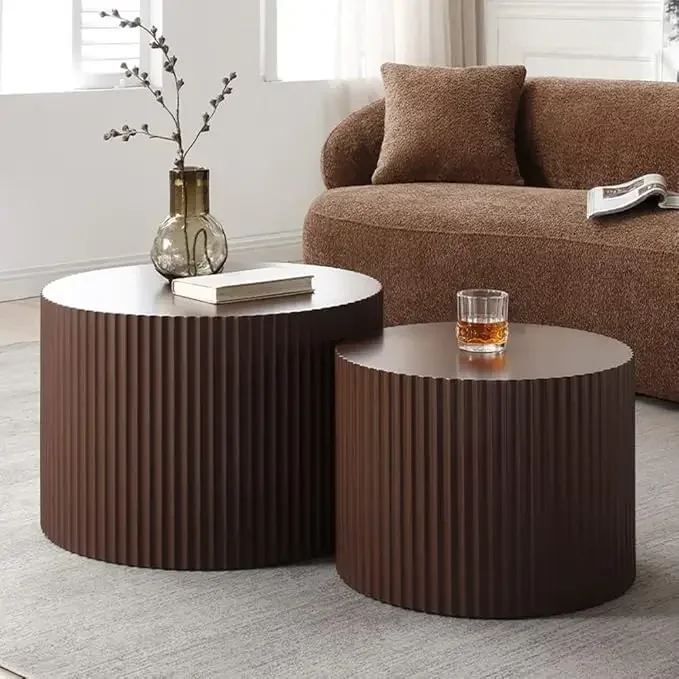
Functional Styling Approaches
Thoughtful styling considers how the table will be used day-to-day:
- Place frequently used items like remote controls in accessible containers
- Position coasters where drinks are likely to be placed
- Create stable, flat areas for setting down glasses or plates
- Consider how styling will accommodate conversation by maintaining appropriate sightlines
Nesting coffee tables offer particularly versatile styling opportunities, as elements can be separated and rearranged to serve different functions or create new visual compositions.
Seasonal Styling Options
Refresh your coffee table’s look throughout the year without major overhauls:
- Rotate art books seasonally to reflect changing colors and themes
- Swap natural elements to reflect seasonal changes—branches in winter, fresh flowers in spring
- Adjust color accents through small decorative objects that can be easily changed
- Incorporate seasonal textural elements like cozy materials in winter or lighter, natural textures in summer
The most successful coffee table styling feels collected rather than contrived, with objects that tell stories and reflect personal interests while honoring the table’s design heritage.
Mid-Century Modern Solid Wood Coffee Tables, Mid-Century Modern Teak Coffee Tables
$879.95 Select options This product has multiple variants. The options may be chosen on the product pageMid-Century Modern Danish Coffee Tables, Mid-Century Modern Oval Coffee Tables, Mid-Century Modern Solid Wood Coffee Tables
$390.05 Select options This product has multiple variants. The options may be chosen on the product pageMid-Century Modern Coffee & End Table Sets, Mid-Century Modern Coffee Table Sets, Mid-Century Modern Oval Coffee Tables
Price range: $257.48 through $331.04 Select options This product has multiple variants. The options may be chosen on the product pageMid-Century Modern Glass Top Coffee Tables, Mid-Century Modern Glass Top Side & End Tables
$460.58 Select options This product has multiple variants. The options may be chosen on the product pageMid-Century Modern Glass Top Coffee Tables, Mid-Century Modern Vintage Coffee Tables, Mid-Century Modern Vintage Side & End Tables
$725.36 Select options This product has multiple variants. The options may be chosen on the product pageMid-Century Modern Lift Top Coffee Tables, Mid-Century Modern Square Coffee Tables
$454.73 Select options This product has multiple variants. The options may be chosen on the product page
Care and Maintenance for Longevity
Proper care ensures your mid-century coffee table remains beautiful and functional for generations. Different materials require specific maintenance approaches to preserve their original beauty.
Wood Care Guidelines
Wood, the quintessential mid-century material, requires regular attention:
- Dust frequently with a soft, lint-free cloth, moving in the direction of the wood grain
- Clean spills immediately to prevent staining or moisture damage
- Apply appropriate wood polish or conditioner every 3-6 months (following product guidelines for your specific finish)
- Use coasters and placemats to protect surfaces from moisture rings and heat damage
- Position tables away from direct sunlight and heating vents to prevent drying and cracking
For tables with oil finishes, periodic reapplication of appropriate oil refreshes the surface and nourishes the wood. Tables with lacquer or polyurethane finishes should never be treated with oils, as this damages the protective coating.
Glass Surface Maintenance
Glass table surfaces require different care:
- Clean with appropriate glass cleaner or a solution of vinegar and water
- Avoid abrasive cleaners that might scratch the surface
- Use microfiber cloths rather than paper towels to prevent lint residue
- Check and tighten any hardware securing glass to bases or frames
- Place soft protective pads between glass and any hard objects displayed on the surface
Marble-top coffee tables require special attention, as marble is porous and can stain easily. Consider applying a food-safe marble sealer annually and clean spills immediately with gentle stone-specific cleaners.
Metal Component Care
For tables with metal elements:
- Dust regularly with a soft cloth
- Clean fingerprints from brass with appropriate metal cleaner
- Maintain chrome with products specifically designed for chrome surfaces
- Address any rust spots immediately with fine steel wool and appropriate protective coating
- Check and tighten hardware connections periodically, as temperature changes can cause expansion and contraction
Preventative Maintenance
Proactive care prevents many common issues:
- Inspect joints and connections every few months, tightening as needed
- Reapply protective felt pads under table legs annually or when worn
- Address minor scratches or imperfections before they worsen
- Rotate table position periodically to ensure even exposure to light and wear
- Keep tables on level surfaces to prevent uneven stress on joints and legs
Seasonal deep cleaning provides an opportunity to assess condition and address any emerging issues before they become significant problems. With proper care, a quality mid-century coffee table will remain both beautiful and functional for decades.
Complementary Furniture to Pair with Your Large Mid-Century Coffee Table
Creating a cohesive living space involves thoughtfully pairing your mid-century coffee table with complementary furniture pieces. The goal isn’t to create a museum-like display of period pieces but rather to achieve balance between statement elements and supporting players.
Creating Cohesive Mid-Century Groupings
For a harmonious mid-century aesthetic:
- Pair coffee tables with end tables or side tables that share similar design elements but aren’t exact matches
- Choose seating with complementary wood tones and proportional scaling
- Incorporate lighting with compatible forms—floor lamps with similar angles or materials
- Add storage pieces that echo design elements from your coffee table
Coordinated coffee and end table sets provide design continuity while maintaining visual interest through slight variations in form or scale.
Mixing Design Periods Effectively
For more eclectic spaces:
- Use your mid-century coffee table as an anchor piece that establishes design language
- Choose complementary pieces that share one common element with your table (material, color, line quality)
- Balance more ornate pieces with the clean lines of mid-century design
- Create conversation between different eras through thoughtful placement and grouping
The key is finding common visual threads that create dialogue between different styles—perhaps the warm wood tone of your mid-century coffee table picks up similar tones in a contemporary sofa, or the geometric patterns in a traditional rug echo shapes in your table’s design.
Balancing Statement Pieces
When your coffee table serves as a statement piece:
- Allow it adequate visual space by keeping surrounding pieces simpler
- Choose supporting furniture with quieter profiles that don’t compete
- Consider neutral upholstery that lets the table’s design shine
- Use textiles and accessories to bridge between statement pieces
The most successful rooms create a hierarchy of visual interest rather than a competition between equally bold elements.
Are Large Mid-Century Coffee Tables Right for Your Space?
While large mid-century coffee tables offer undeniable visual impact and functional benefits, they aren’t ideal for every living environment. Consider these key questions when determining if a large mid-century table suits your specific situation:
Do you have adequate clearance for comfortable movement?
Large coffee tables require sufficient space around their perimeter—ideally 18-24 inches (46-61 cm) between the table edge and surrounding furniture. Without this clearance, the room will feel cramped and movement will be restricted. Measure carefully before committing to a large piece.
Does your room scale support a substantial table?
In general, rooms under 200 square feet (18.5 square meters) may feel overwhelmed by very large coffee tables. Consider both visual and physical space—a glass-top table might work in a smaller room because it maintains visual openness despite its footprint.
Do your lifestyle and household members accommodate a large fixed piece?
Households with small children might benefit from rounded corners and sturdy construction. Active households that frequently rearrange furniture for different activities might prefer smaller, more mobile pieces or nesting tables that offer flexibility.
Would your space benefit from alternative approaches?
Some situations better suit different solutions:
– Two smaller coffee tables that can be rearranged as needed
– A coffee table with nesting components that can expand when required
– An ottoman with tray that serves as both footrest and table
– A series of coordinated side tables instead of one central table
For rooms with challenging layouts, the features of rectangular coffee tables may provide better space utilization than round or organic shapes, which often require more generous clearance around their perimeters.
Common Questions About Large Mid-Century Coffee Tables
What differentiates authentic mid-century tables from reproductions?
Authentic mid-century tables (those actually produced during the 1940s-1960s era) typically feature construction methods specific to that period, materials that have naturally aged, and often bear maker’s marks or labels. Quality reproductions honor original designs with proper proportions and appropriate materials but utilize contemporary production techniques. Both can be valuable additions to your home—authenticity matters most if you’re collecting from an investment perspective.
How do mid-century coffee tables compare to other design styles?
Mid-century tables generally feature cleaner lines than traditional styles, with less ornamentation and more emphasis on form following function. Compared to contemporary styles, mid-century pieces often incorporate warmer materials and more organic shapes. Industrial styles share mid-century’s honesty of materials but typically use rougher textures and more salvaged elements.
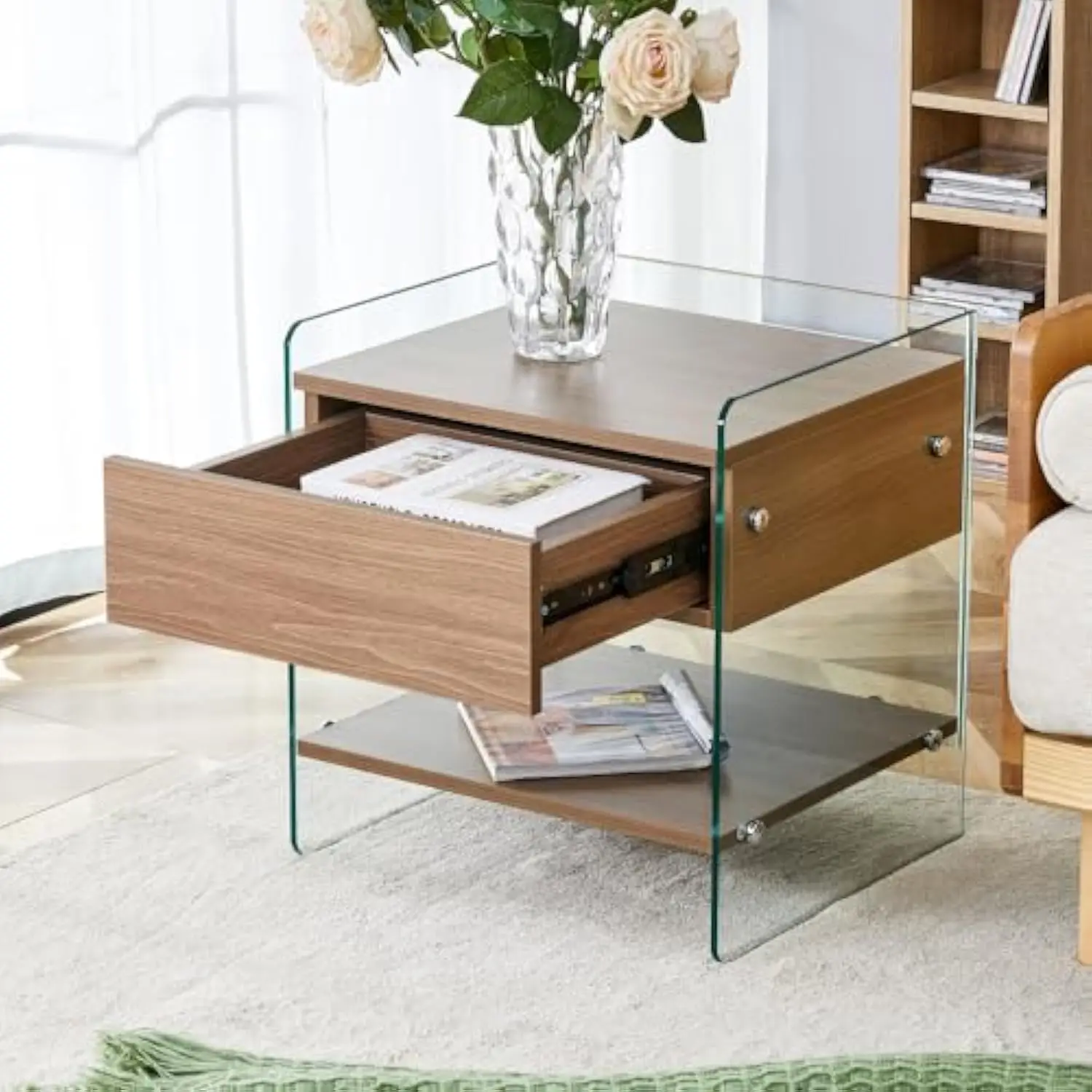
How durable are glass-top mid-century coffee tables?
Quality glass-top tables feature tempered safety glass that resists breaking and, if broken, shatters into small, less dangerous pieces. With proper care, these surfaces withstand daily use for decades. The key is ensuring the glass is properly secured to its base and protecting it from direct impacts and extreme temperature changes.
What makes a large round coffee table work in a room?
Round coffee tables excel in square rooms, spaces with multiple traffic patterns crossing around them, and settings with curved or angular seating arrangements. They eliminate sharp corners, creating safer environments for households with children. The key to successful placement is ensuring adequate clearance on all sides while maintaining proper scale relative to surrounding furniture.
How can I incorporate a statement coffee table without overwhelming my space?
Balance is crucial when featuring a substantial coffee table. Keep surrounding elements simpler, ensure adequate negative space around the table, and consider the table when selecting other focal points in the room. Using a consistent color palette helps integrate even the most distinctive tables into a cohesive space.
How should table height relate to seating height?
For optimal comfort, coffee tables should be approximately the same height as or slightly lower than sofa seat cushions. This typically means a height of 16-18 inches (41-46 cm). Tables significantly lower create uncomfortable reaching, while taller tables interfere with sightlines and can feel awkward when seated.
At Hearth Forms, we understand how a thoughtfully selected coffee table transforms not just the look but the entire functionality of your living space. The perfect large mid-century coffee table becomes both a practical surface and an artistic statement that anchors your room for years to come.

